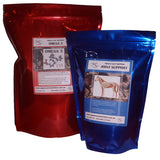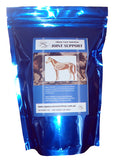Feeding the foal
 The nutrition a foal receives in its first 18 months of life help set the foundations for healthy musculoskeletal development and future athletic potential, or can lead to developmental disorders that can plague the horse for the rest of its life, curtailing a performance career. As owners, it is during this time that we can probably have the greatest impact on the future athletic potential of the horse. By 18 months of age the horse will have achieved 90% of it’s mature height, and almost that percentage of mature weight. During this period he will have gone through three important nutritional phases: nursing, creep feeding and weaning.
The nutrition a foal receives in its first 18 months of life help set the foundations for healthy musculoskeletal development and future athletic potential, or can lead to developmental disorders that can plague the horse for the rest of its life, curtailing a performance career. As owners, it is during this time that we can probably have the greatest impact on the future athletic potential of the horse. By 18 months of age the horse will have achieved 90% of it’s mature height, and almost that percentage of mature weight. During this period he will have gone through three important nutritional phases: nursing, creep feeding and weaning.
During nursing, correct nutrition for the dam provides for the foal’s needs. At around 8 weeks of age creep feeding comes into play. Although the foal is still nursing, milk production starts to decline from this point, and the foal may not be getting all of his nutritional requirements through nursing alone. By now, he will be eating pasture and/or hay and trying out his mum’s hard feed. To ensure both foal and mum are getting adequate nutrition, creep feeders allow access for the foal but not the dam. Creep feed should be formulated specifically for growing horses and should provide approximately 14-16% crude protein, 0.7-0.9% calcium, 0.5-0.6% phosphorous, 50-90 ppm (parts per million) copper and 120-240 ppm zinc. Whole grains are not such a good choice as they tend to be low in calcium and copper which are important nutrients for the growing foal. Creep feed should not be given free choice as you do not want the foal overeating and gaining weight too quickly. Instead, feed at a rate of 0.5-1% of the foal’s body weight per day. Research suggests that as well as benefitting health and development, creep feeding also helps with the next phase in the foal’s life by helping reduce weaning stress.
Once the foal is fully weaned he should be provided with good quality pasture or hay and a measured amount of concentrate formulated for growing animals. This should be offered at 1-1.5% of the foal’s body weight per day and contain 14-16% crude protein, 0.8% calcium, 0.5% phosphorous, 50-80ppm copper and 100-200ppm zinc. It is important not to overfeed concentrate as this can lead to rapid growth which can harm musculoskeletal development. Rapid growth and weight gain, as well as dietary imbalances, have been implicated in the occurrence of Osteochondrosis Dessicans, a developmental disorder that affects 5-25% of the horse population. This joint disorder may be detected as early as 5 months of age or as late as skeletal maturity, but it is commonly diagnosed around 1 year of age. Other disorders that fall within the category of Developmental Orthopaedic Disease include physitis (changes in the growth plate), angular limb deformities (outward or inward deviation of the lower legs), flexural deformities (tightening or shortening of the flexor tendons in the lower leg), subchondral cystic lesions (fluid filled cysts occurring within the bone), cervical vertebral malformation (compression of the spinal cord in the neck) and cuboidal bone malformation (malformation of the small bones in the hock or knee). Six areas have been identified as known causative factors in Developmental Orthopaedic Disease including high rates of postnatal growth with unbalanced diets.
The amount of daily weight gained by the foal slows as he ages. For a horse with an expected mature weight of 500kg, he should be gaining approximately 0.84kg/day as a four month old, 0.72kg/day as a six month old, and 0.45kg/day as a yearling. Regular monitoring of body condition scores is the easiest way for most owners to keep an eye on their foal’s development. The 9 point scale, with 1 being emaciated and 9 being extremely fat, was developed by Don Henneke and describes fat/muscle coverage at six points on the body: neck, withers, back, tailhead, ribs, behind shoulder. A healthy body score for the developing foal would be between 4 and 6. A ‘5’ horse (moderate/’ideal’ weight) has a level back, with ribs that can be felt, but not easily seen. The withers are rounded and shoulders and neck blend smoothly into the body, whilst fat around the tailhead is beginning to feel spongy. Ideally the foal’s nutritional needs should be balanced to his growth requirements to maintain a healthy body condition score throughout, without drops in condition followed by compensatory growth spurts.
By the time the foal is on the ground, the die is already cast in terms of genetic susceptibility to developmental conditions, and there is only so much we can do to mitigate accidents and trauma. But what we can do is ensure that we give our foals the very best nutritional management for healthy development, and lay a strong foundation for future athletic performance and a long and happy life.
|
RELATED PRODUCTS |
|||
 |
 |
 |
 |
| Lysine | Hoof Builder |
Joint Builder |
Joint Support |